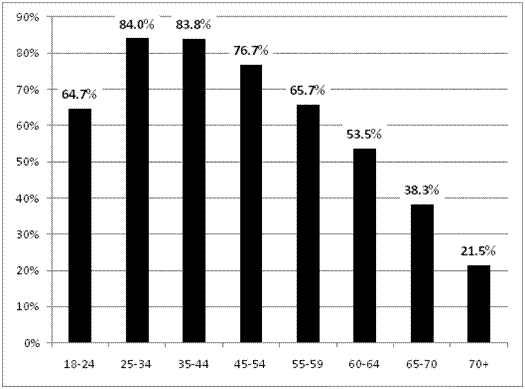At this year’s Annual Conference of the Canadian Economics Association, Armine Yalnizyan gave a presentation entitled “Surviving the Recovery: The Distribution of Canadian Household Debt.” The panel was co-sponsored by the Canadian Association for Business Economics and the Progressive Economics Forum.
As Armine made clear in her presentation, household debt in Canada has steadily risen over the past two decades. In 1990, the average Canadian household had debt representing just under 90 per cent of its personal disposable income. Today, that figure stands at roughly 150 per cent.
But some groups are affected more than others. The chart below (used in Armine’s presentation) gives a breakdown of which age groups in Canada are most likely to hold household debt. Clearly, those Canadians most likely to be in debt are over the age of 25 and under the age of 45.
I can’t help but make two observations here. First, this is precisely the age group most likely to be struggling with student debt. Second, student debt in Canada has risen quite dramatically in recent years. According to the Canadian Federation of Students, average student debt for a four-year degree in Ontario has increased by 175 per cent — from roughly $8,000 to roughly $22,000 — in the past 15 years.
It therefore seems to me that one very direct way for senior levels of government to tackle rising levels of household debt in Canada is to reduce student debt — by reducing tuition fees, improving student financial aid programs or both.
This article was first posted on The Progressive Economics Forum.
Thank you for choosing rabble.ca as an independent media source. We’re a reader-supported site — visited by over 315,000 unique visitors during the election campaign! But we need money to grow. Support us as a paying member (click here) or in making a one-off donation (click here).




